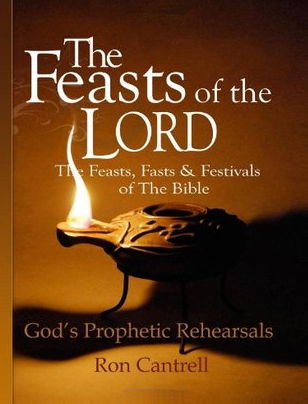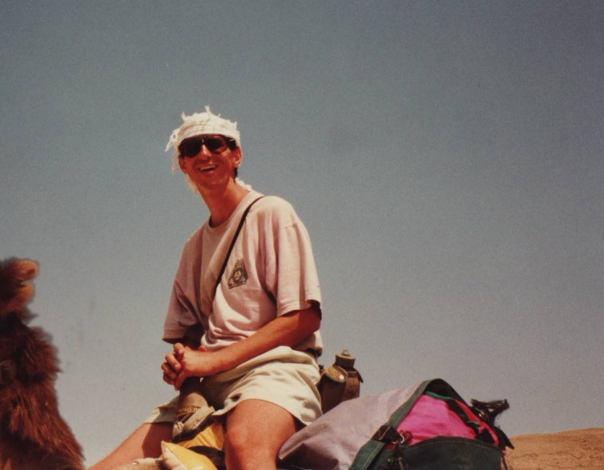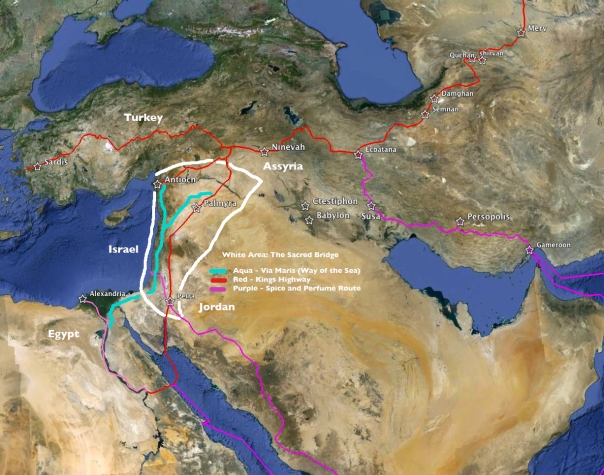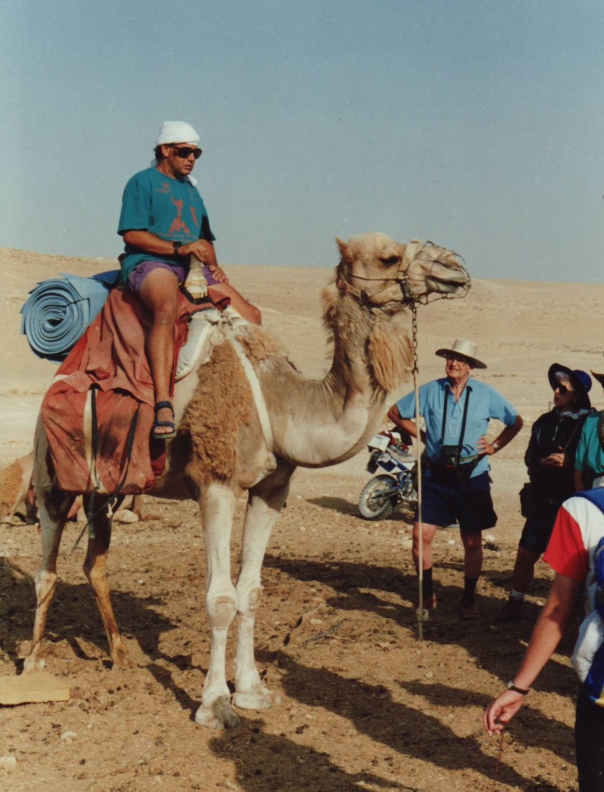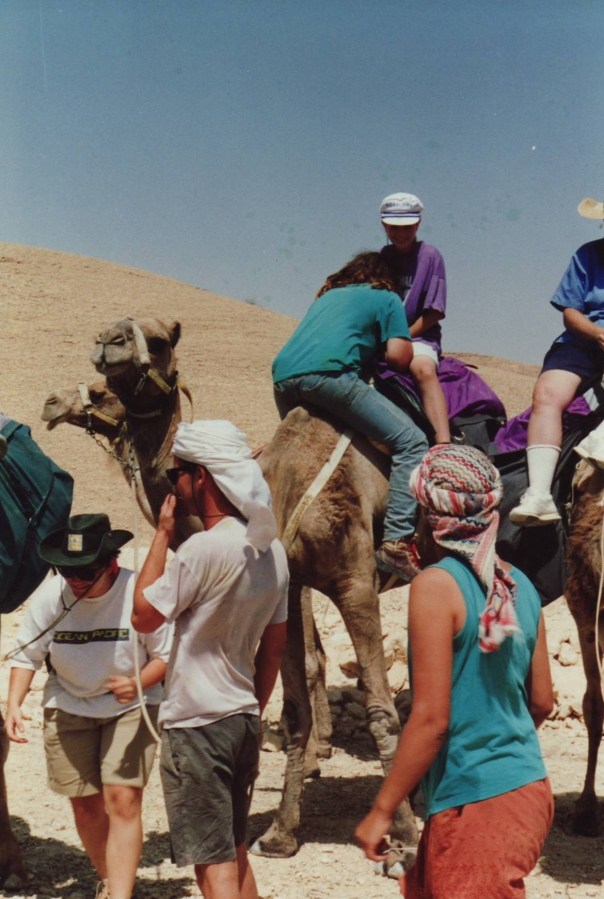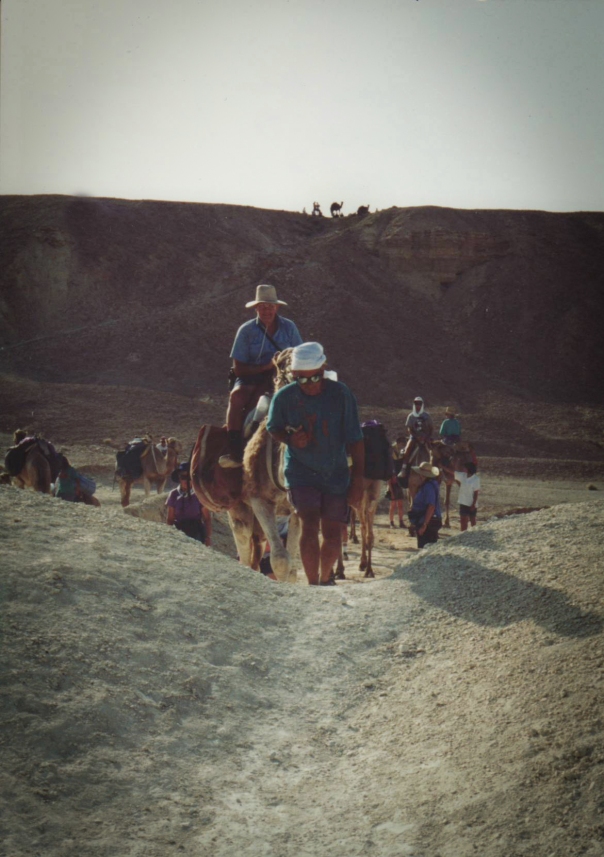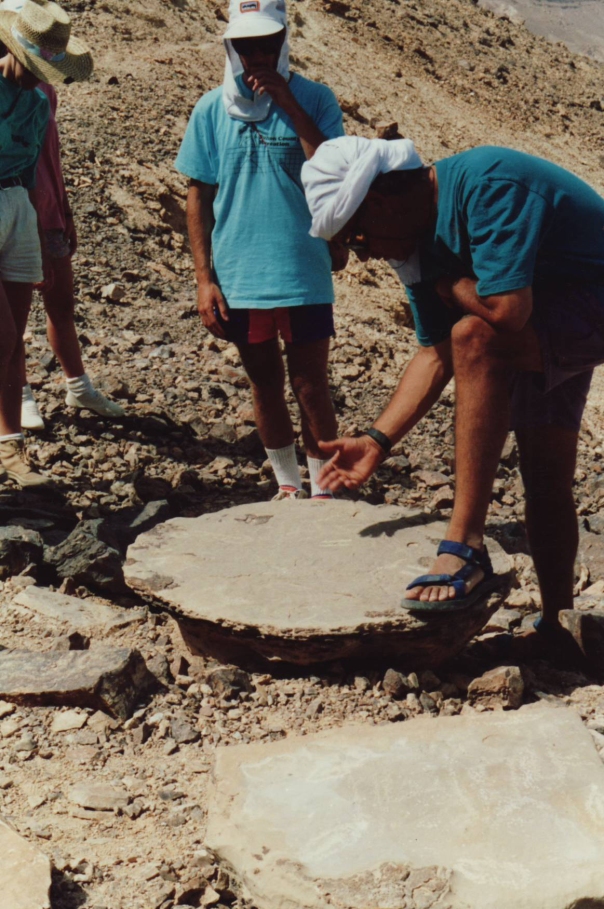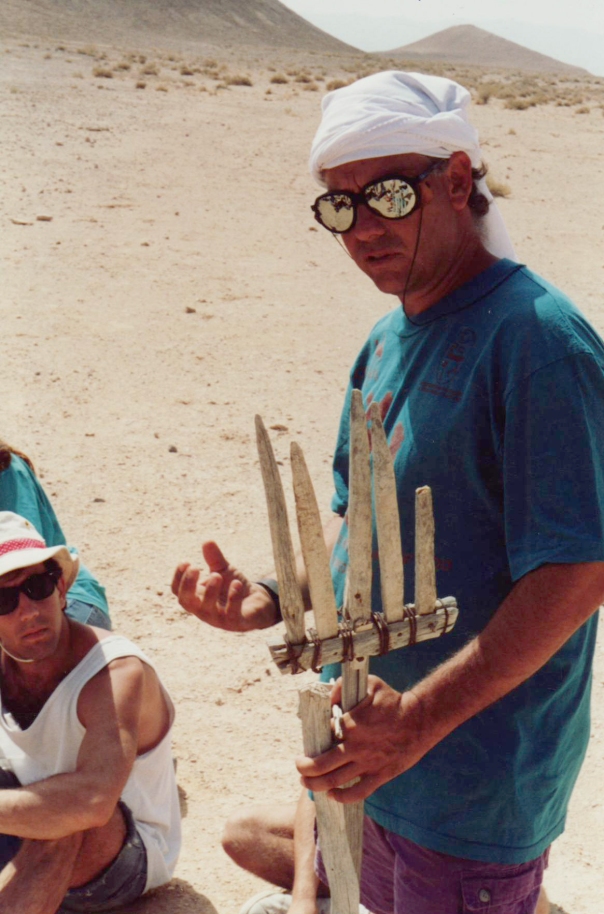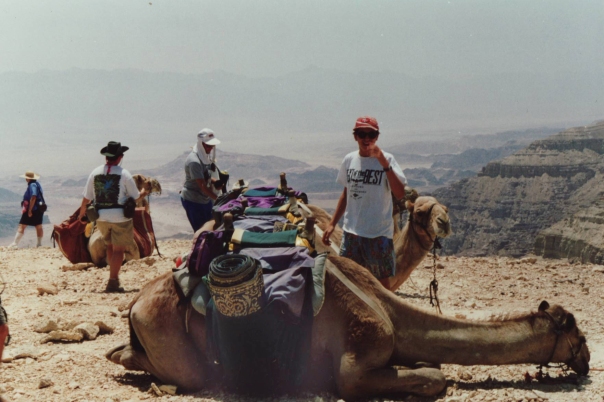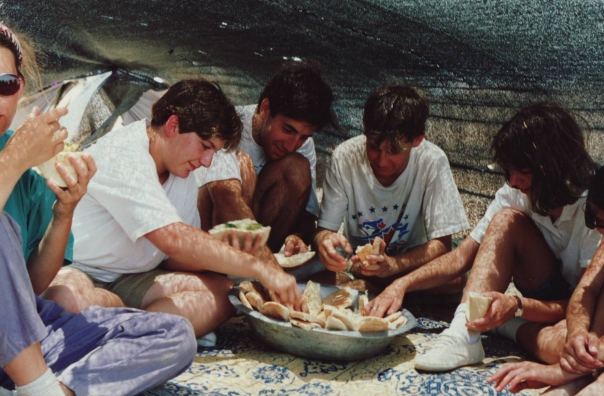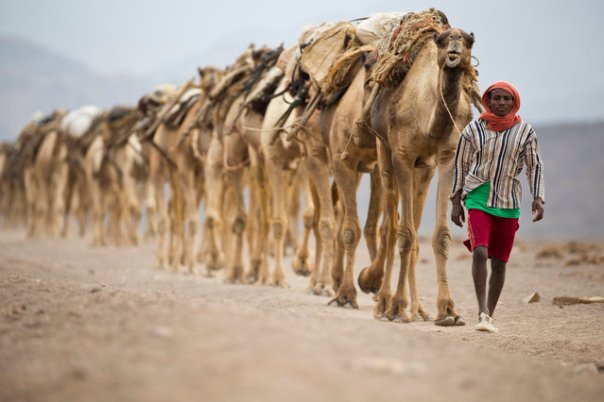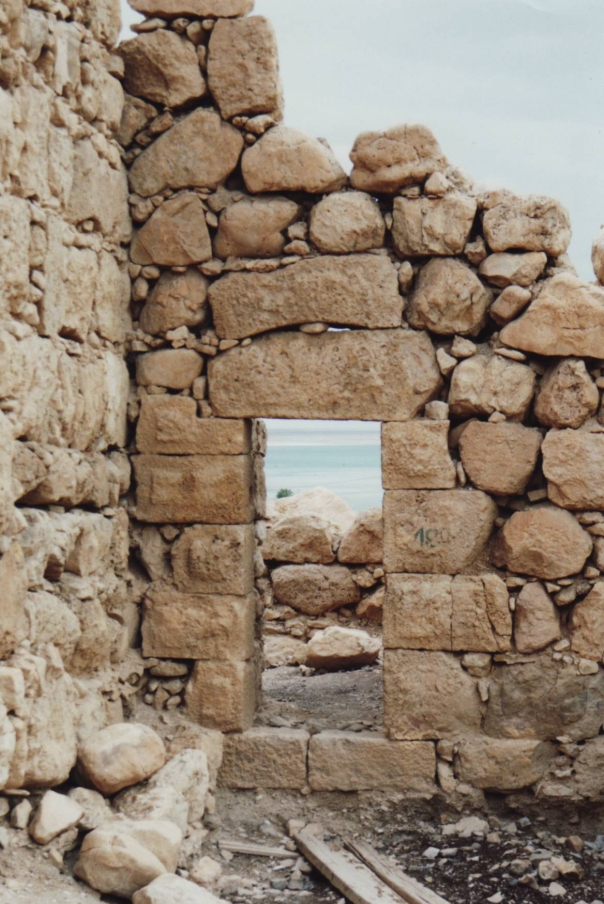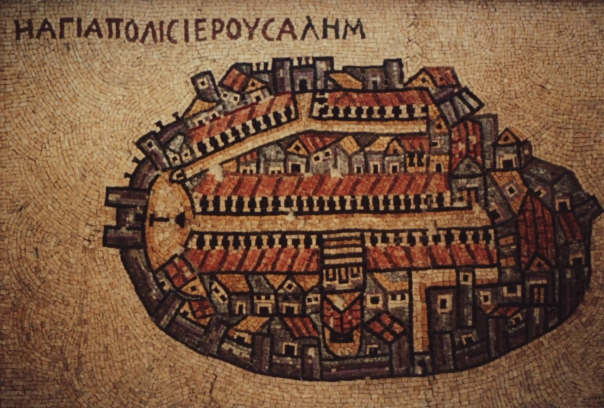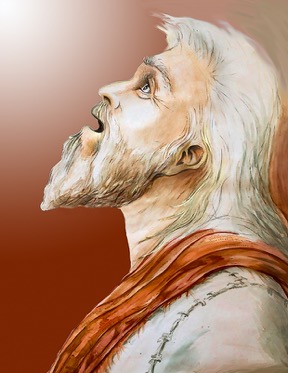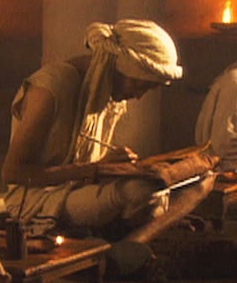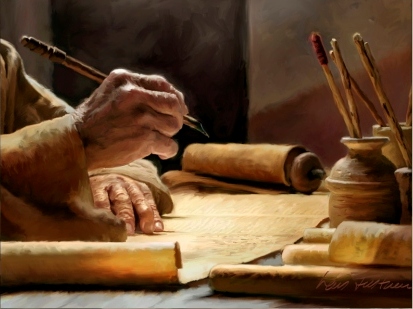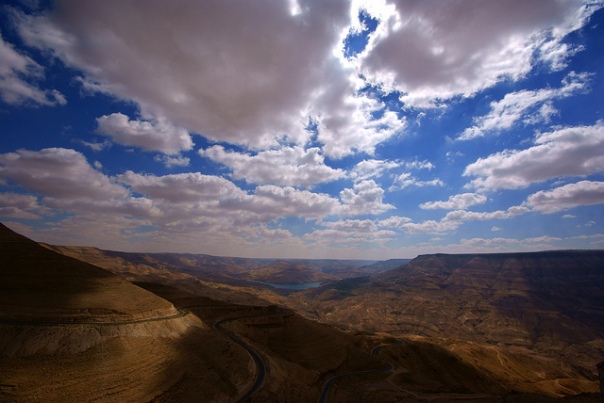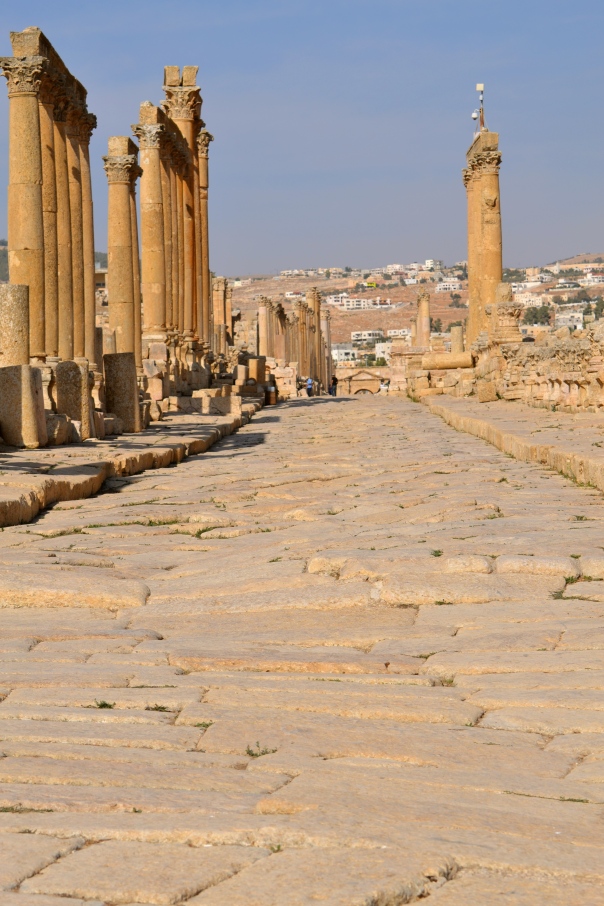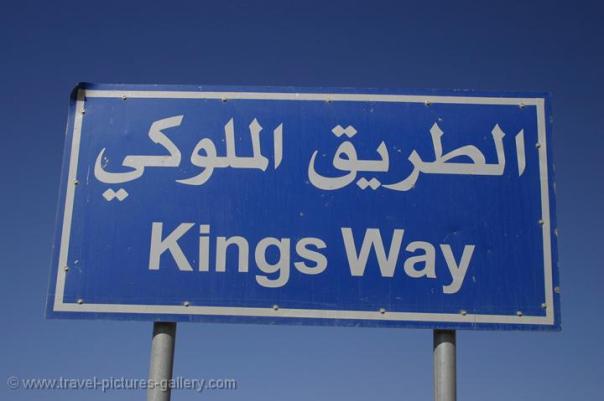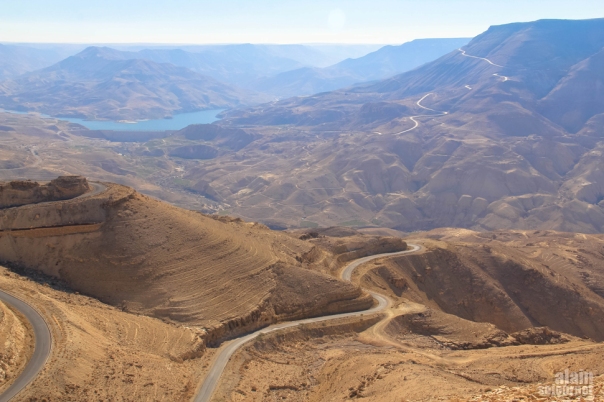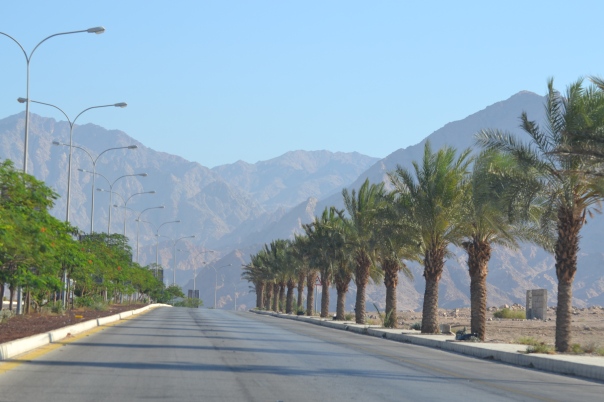Blog Archives
Happy Hanukkah!
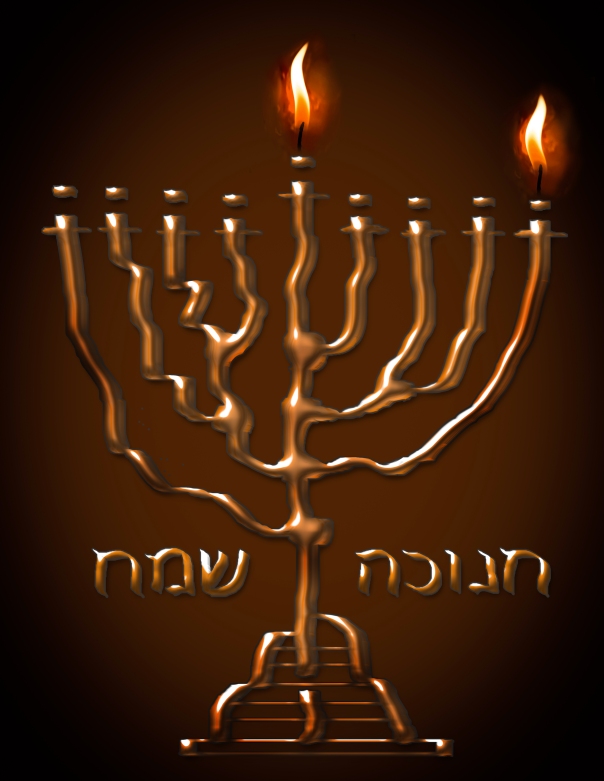
Art by Ron Cantrell
On this first night of Hanukkah, we wish all our Jewish and Israeli friends a season of the Light of Yeshua.
Hanukkah: Eight Nights of Light
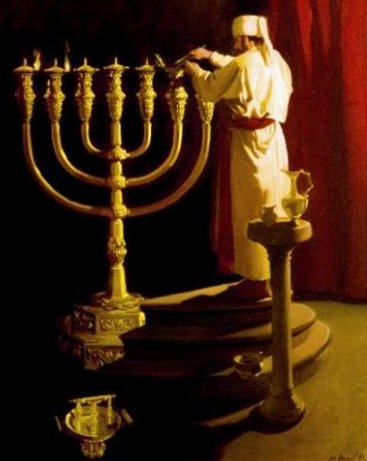
The time between the Old Testament and the New has traditionally been known as the silent years. But a fictional novel could not hold more intrigue or imaginative narrative than this period. Historians who have not fallen under the “spell of silence” have left us enough information to glean valuable lessons from Hanukkah.
Hanukkah is a story of survival, bravery, overcoming faith, and a sovereign God. These lessons are too rich to ascribe to a silent past. They cry out, of themselves, to be paid attention to. If they had been heeded, needless deaths might have been spared during the Holocaust.
Purim follows in the spring on the heels of Hanukkah. Purim is also a story about survival. The thread that binds both stories is God’s protection over the Jewish nation, His chosen people. One story takes place in the diaspora (lands where the Jewish people were dispersed from Israel) and the other takes place in “Greek occupied” Israel. These stories take place hundreds of years apart. Esther is dated approximately 460 B.C., and the saga of the Maccabees—Hanukkah—takes place about 160 B.C.
Both of these stories were dictated to the mind of scribes by God’s Holy Spirit, I am sure, to leave us an indelible message. The message is that in the face of enormous odds, with God, we are victorious.
When we were still living in Jerusalem I attended services at our congregation where our former British guest speaker, Lance Lambert, a Jewish believer who lived in Jerusalem many years, was speaking on “The Hanukkah Connection.” Some of his thoughts are worth adding here as an introduction.
David Ben Gurion, upon being asked to create a seal for the new State of Israel, chose two olive branches surrounding a menorah. It stands as the Israeli State Seal to this day. On each of the seven cups of the menorah (seven-branched candlestick) is one word:
“Lo B-chil, U’Lo B’Koach, Ki Im B’Ruachi,” —Not by might, nor by power, by my Spirit, saith the Lord of hosts.”
This picture is from Zechariah 4:6, at which time they were rebuilding the Temple after the Babylonian captivity. Remember the word Hanukkah in Hebrew simply means “dedication,” specifically of the Temple of God.
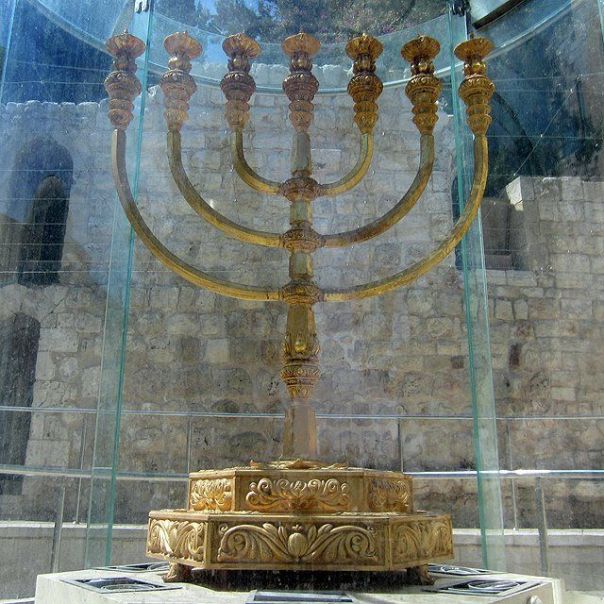
Gold reconstruction of the Temple Menorah stands now near the Western Wall in Jerusalem.
The menorah (candlestick) stands as a symbol in so many passages of Scripture. Revelation tells us that the seven churches of Asia were represented in the heavenlies by a candlestick. Also Israel is represented by the menorah in Zechariah. John in his Gospel records that Jesus is the light of the world and lights every man. Zechariah goes on to record something interesting in relation to this just after the “not by might” section mentioned above.
Zechariah asks about the meaning of the vision of the two branches who are pouring oil from themselves. Of course, this oil is symbolic of the Holy Spirit of God, but it is interesting to note that in Hebrew it does not say that they were pouring just any oil from themselves, but it says that they were pouring “gold,” not even golden oil. The word “oil” placed in most translations is in italics, meaning it is inferred by the translator. In the context of the rebuilding of the Temple, and the power coming from the Holy Spirit, the Hebrew word picture is without rival.

Yeshua said, “I am the Light of the world.”
In John 10:22, Jesus is recorded as walking in the area of Solomon’s colonnade during the Feast of Dedication, which is Hanukkah. As was usual with Jesus, He tied His message to the events of the people. He took that opportunity to declare that HE was the Light of the world.
The Servant
It is interesting to note that the candlestick used by the Jewish people during Hanukkah, called a hanukkiah, has eight candles and one extra one called the shamash, or “servant”. The symbolism of the eight candles is discussed below, but the symbolism of the “servant” candle for us as believers is worth mentioning. Jesus, the Servant, is the light of all men. According to the rules of this holiday, all the candles of the hanukkiah must be lighted from the one called the shamash.
Hellenization of the Region
Josephus, the historian of antiquity, left important documentation of that period. The bulk of the story of Hanukkah is found in the book of Maccabees (one of the books of the Apocrypha; this collection of works was preserved by the formal church), and mention is made of the Feast in the New Testament. In the book of John, just after Jesus has declared himself to be the Light of the world, he is found walking in Solomon’s Colonnade. John tells us that it was in winter during the Feast of Dedication (John 10:22).
This holiday holds more historical resource in Christian literature than it does in the literature of the Jewish people. Actually the holiday is not mentioned at all in the Old Testament because it happened after the closing of Malachi.
This drama of Hanukkah begins with Alexander the Great. His conquest of the then-known world began in Greece in the fourth century B.C. Alexander was so highly ambitious that he conquered the world by the age of 23. The book of the prophet Daniel portrays him, symbolically, first as a leopard and later as a horned goat who charges so swiftly that he does not even touch the ground (Daniel 7:6, 8:5-7).
Thus, via Alexander the Great, began the hellenization of the world. The Greek philosophers’ ideas, the glorifying of the human body, both in sport and in fine art, and the Greek way of perceiving the universe around us, permeated the world.
Though our story of the Maccabean revolt against the Syrian-Greeks takes place much later, Alexander’s conquest of the world is actually the foundation of those events. At his death, Alexander’s empire was split into four parts. The four major generals of his vast army divided his conquests amongst themselves. Seleucus, one of Alexander’s generals, took what later became modern Syria. It was under the iron fist of this sector of the divided empire that Israel came to a time of great trouble.
Several generations from Seleucus, a maniacal ruler came to power known as Antiochus Epiphanes. His Greek name actually means “god in the flesh.” Antiochus ruled from Syria but set up a military garrison in Jerusalem. This garrison was to oversee the hellenization of the population of Israel.
Antiochus had the high priest Onais murdered. He demanded that the circumcision of all Jewish baby boys cease. He had a statue of Jupiter (Zeus) erected on the Temple Mount and the sacrifice of swine on the altar was instituted.
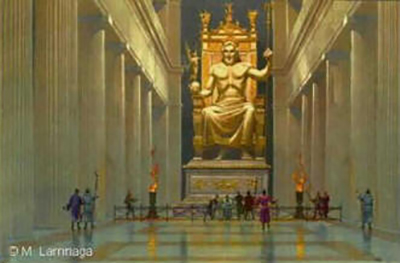
Statue of Zeus at Olympus, a similar looking one was installed in the Jerusalem Temple
The Syrian-Greek military garrison met their demise upon entering a small village outside Jerusalem called Modi’in. The soldiers built an altar and demanded a “show of allegiance” by having the local elders sacrifice a pig there. An old Jewish priest named Mattathias became so enraged when he saw what was taking place that he killed the Jew who was complying with the orders. He and his sons fled to the nearby mountains to regroup and prepare to wage guerrilla warfare against the oppressive authorities.
Mattathias, being elderly, passed his leadership on to his son Judah, known as the Maccabee (meaning “hammer”) prior to his death. Judah defeated every attempt by Antiochus to end his uprising. His strategy and bravery could not be matched by the other side. In the face of astounding odds, Judah led his followers to Jerusalem where he drove the Syrian force out of the city.
Judah faced the grief of having to fight against his own Jewish brothers who had joined the side of the hellenizers. Some forsook their Jewishness for monetary gain, others for prestige. In order to participate in Greek sporting events which were conducted in the nude, some of his Jewish brothers were so determined to be hellenized that they endured painful surgery to reverse their circumcisions, thereby erasing any sign of their tie to their Jewish heritage. Many died from the dangerous operation.
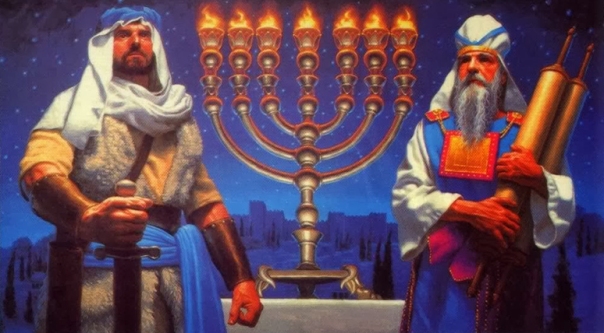
Judah Maccabee — the Hammer — moves to rededicate the temple and rekindle the temple menorah.
On the twenty-fifth day of the Hebrew month Kislev, exactly the same day that three years earlier the Temple had been defiled by unholy sacrifices, the Hasmonean brothers and their followers liberated the city and began in earnest to undo what their oppressors had done. They rushed to rededicate the desecrated Temple.
Arriving at the Temple site, they began removing the stones of the defiled altar and toppling the statue of Jupiter. In the holy place inside the Temple stood the huge menorah (the great olive oil lampstand). The rejoicing Jewish conquerors found only enough oil to light the menorah for one day. The joy of the conquest of liberation was diminished due to the laws stating that the menorah must burn continually. The time it took to process enough oil to replenish the menorah was eight days. How could they possibly begin the process and let it die again? Nevertheless, they lit the menorah and began the process of procuring more oil.

The stamp of God’s approval of their deeds of valor was evident when the oil which should have lasted for only one day lasted the entire eight days until the new oil was brought. For this reason the holiday is also known as the “Feast of Lights.”
Modern Hanukkah Traditions
The traditions of the Feast of Hanukkah that have evolved over the years are the lighting of an eight-branched menorah (candleholder) called a hanukkiah. One candle is lit each night by a candle known as the shamash, or servant in English. Thus the hanukkiah candleholder has nine candles. The candles are lit in a right-hand to left-hand order, adding another candle each night.Hanukkah candles come in boxes of 44 since lighting one more each night of the eight nights of Hanukkah adds up to 44.The frying of potato pancakes in oil is traditional to commemorate the oil used the light the Temple Menorah so long ago.Games are played with a four-sided top called a dreidel. Each side of the dreidel has a Hebrew letter on it standing for the slogan:
Nes Gadol Hiyah Po—“A Great Miracle Happened Here.”
In all places outside of Israel the dreidel has the letters slightly different, standing for Nes Gadol Hiyah Sham—“A Great Miracle Happened There.”
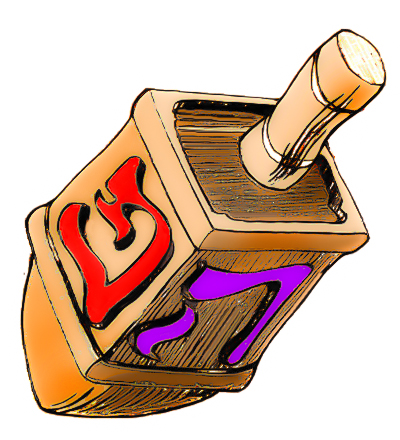
The Children’s Toy Dreidel
Story-telling is Popular During Hanukkah
The book of Maccabees is read, wherein lies the story of the bravery of those zealous of God’s ways. Women played a role as well in this great drama. These stories are related concerning Israel’s women of valor.
One is about a woman named Judith who, upon seeing the desperate plight of her people, left Jerusalem and arrived at the Syrian encampment. She pleased the Syrian general and he, thinking to have her for himself, consented to her preparing him a meal first. Judith knew that serving salted cheese would make the general thirsty whereby she could give him too much to drink. He complied, drinking wine until he passed out. Judith, seizing the opportunity, killed the Syrian General. When the Syrians learned of Judith’s deed, they fled.

Judith kills Holophernes.
Another story of a woman of valor relates that the Syrian governor passed a law that every Jewish bride would be brought to his bed chamber first on the night of her wedding. The daughter of the high priest, upon hearing this, made plans for her own wedding ceremony. After her vows she stood amidst the people disrobing, almost like the prophet Jeremiah at a much earlier time, which, of course, enraged the crowd. Her brothers shouted that they would kill her, to which she replied, “Over my being disrobed you are angry, but about what the Syrian governor will do to me tonight you remain silent?” Being roused to righteous anger, her brothers stormed the palace and killed the Syrian governor, and the revolt began.
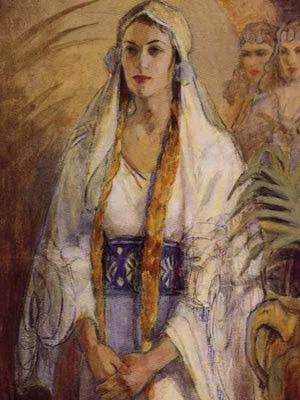
The daughter of the high priest on her wedding day.
What Does This Mean for Us?
This story is a tale repeated time and time again by the Jewish people—a story of overcoming in the face of overwhelming adversity. From the book of Genesis to the Maccabees the Jews have overcome Egyptians, the desert and its dangers, felled the walls of Jericho with rams’ horns, quelled the giants of the promised land, and led three Babylonian kings to the throne of God the Almighty.
From the Maccabees to present day, there have been a string of miracles, but to answer Isaiah’s rhetorical question, “Can a nation be born in a day?” Yes, indeed it can and in the face of such overwhelming odds as to be absurd should anyone simply have penned the story as a novel.
Our lesson from this holiday is that we can overcome with Him. We will face Antiochus again in the visage of the Anti-Christ and God’s people will overcome. His empire will once again be shattered. This time God’s people will watch because it will be done without hands, according to Daniel, but it will come to an end. In all this we can take courage—God is ever present in the annals of men.
The Local Flavor
One of the best places to take an after-dark walk during Hanukkah is the Jewish Quarter of the Old City of Jerusalem. The Quarter sits nestled inside walls rebuilt by Suleiman the Magnificent, sultan of the once powerful Turkish Moslem Ottoman Empire which ruled here from A.D. 1517 until the British brought this kingdom to an end in A.D. 1917.
Hanukkah candles are meant to be lit in a window facing outward to shed their light into the street. The beautiful architecture of the Jewish Quarter is the perfect environment. Narrow walkways between tall buildings made of creamy limestone seem to wait for candles to illuminate their soft façades. Long narrow passageways are warm and softly glowing. Bright spots punctuate the dark passageways, bringing to mind the lighting of a Rembrandt painting. Each succeeding evening an extra candle graces the Hanukkah menorah, shedding even more light.
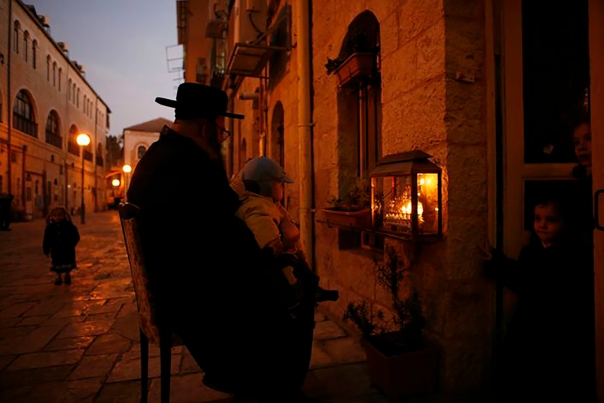
Streets of the Jewish Quarter as the sun sets on Hanukkah.
I often would take such a walk—a lazy enjoyable Friday night — with daydreaming of what it must have been like when our Messiah walked in the same area. It seems that even Jesus enjoyed such a walk. John chapter 10 records His walking in Solomon’s Colonnade, which is in the same area. His walk is recorded to have been during the Feast of Dedication. Jesus had just finished healing a blind man’s eyes and declaring himself the Light of the world—the Light shining into darkness setting those free who are willing.Again, the Hebrew word Hanukkah means “dedication”. It comes from the dedication of the Temple, both in Solomon’s time and in the time of the Maccabees, who rededicated the Temple desecrated by Antiochus Epiphanes in 167 B.C.
The Jewish Quarter sits very high on a hill inside the confines of the walls of the Old City of Jerusalem. As one approaches the Temple Mount area, the topography drops off sharply into a valley. The view is spectacular both by day and by night.
My walk would bring me to the edge of that valley to the staircase which leads down to the Western Wall plaza where the Jewish people pray today. There my daydream ended and I was brought back to reality. Riding the east wind coming from the Mount of Olives was the voice of the Moslem muezzin declaring that “allah is the great god and that mohammed is his prophet.” The contrast was almost too vivid.
City of light, city where the Light walked and healed and illumined the dark eyes of some and the dark minds of others, sits in spiritual darkness. Jerusalem is Ground Zero for future attempts of God’s enemy to usurp His authority. That enemy works through people and the stage is being set for confrontation. Jerusalem will become more and more the focus of international news’ attention. Things will never become politically acceptable here for the western world. On the contrary, Jerusalem is appointed to become a cup of trembling to the nations.
But yet there is light. The symbolism of the eight-candle menorah being lit by a ninth candle called “the servant” is a reminder of the servanthood of the Messiah. Psalm 36:12 says, “For with You is the fountain of Life, in Your light we see light.”
We are, in a manner of speaking, like the Hanukkah menorah—servants called to illuminate those around us and to ever increase the light. During Hanukkah see the candles being added nightly until the glow almost drives back the chill of winter in the limestone city. Our job is to continue to drive back the chill of winter with light.
Hanukkah is a time when God encourages us to persevere in the face of crushing pressures.
Pray for the Jewish community around the world and Israel during this time. May the Light of the world be revealed in and through us all ever brighter and brighter.
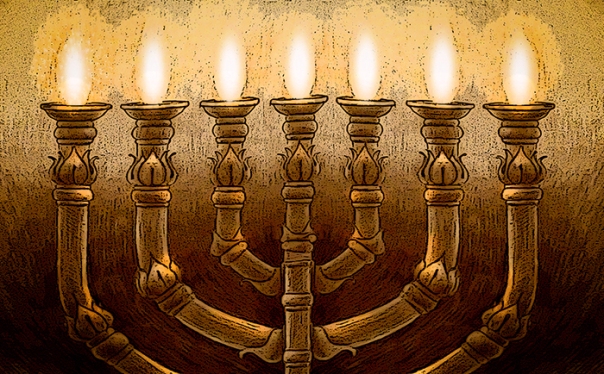
The Temple Menorah, drawing by Ron Cantrell
Hanukkah: Eight Nights of Light Video
Watch the video that we produced in Israel with Ron Cantrell teaching from Jerusalem:
THE SACRED BRIDGE
Adventure on the ancient main trade routes of the Middle East.
A relatively thin slice of land along the Mediterranean Sea has been called, “The Sacred Bridge,” by scholars. In the place where nations have rubbed shoulders with one another for thousands of years, the changes have been only in the surface of the highways: narrow dirt paths gave way to Roman paving stones, later to asphalt, then to super-highways. A region with thousands of years of history make the mind reel for those of us birthed in a nation that is a mere 238-years old.
The vast desert to the east of the bridge kept international trade routes in a narrow corridor near the Mediterranean Sea. The Via Maris, “the Way of the Sea”, (in aqua) runs parallel to the Mediterranean Sea near the coast. The Kings Highway (in red) runs along the crest of the mountains of Moab and Ammon on the east of the Jordan River and Dead Sea (known as the “Salt Sea” in biblical times). The Spice Route (purple) ran from the Arabian Peninsula through Petra, intersecting both the King’s Highway and the Via Maris, then on to the sea at the southern-most port at Gaza.
By no accident, the Sacred Bridge was the site of God’s greatest advertising campaign. The choice was dictated by location — the place where the nations continually passed by. In the midst of cultures given to the worship of many gods, God’s people living in Jerusalem stood as a beacon of truth: the worship of One God, the only God. The book of Acts, chapter two, reads like a United Nations gathering on the day in which God’s fire was poured out. The nations mentioned ring the Sacred Bridge like the spokes of a wheel. No one present would return home silent about what they witnessed that day. In the next week over 8,000 locals and visitors came into the Kingdom of God and were publicly baptized.
This bridge plays no less a role in the future than it has in the past in spite of modernization and progress. Isaiah 19 spells out it’s importance explicitly.
On that day there will be a highway from Egypt to Assyria. Assyria will go to Egypt, Egypt to Assyria, and Egypt will worship with Assyria. On that day, I Israel will form a triple alliance with Egypt and Assyria—a blessing within the land. The Lord of Hosts will bless them, saying,
‘Egypt My people, Assyria My handiwork, and Israel My inheritance are blessed'” (Isaiah 19:23, 24, HCSB).
I am not alone in wanting to visit, see, smell, taste and experience the cradle of history. It is alive with the glory of our God, recorded in the Love Letter He left us. Millions come annually, in spite of danger and turmoil, to breathe in the most historically-famous place in the world.
It’s a place where the “Greats” passed through: from Alexander the Great to Napoleon Bonaparte. However, they were mere visitors on a web of ancient highways taking goods and people from Africa to Europe and Asia. A network of byways connect the major highways and have remained as ancient as they were thousands of years ago. It’s to this place that my wild heart is drawn. I love the adventure and the extreme heat, scorpions and dangers of that famed dusty path known as the “Spice Route”.
CAMEL -TREKKING THE ROUTES
Carol and I have recently traveled the King’s Highway through Jordan: from the Red Sea Port, to Saudi border and all the way up to the Syria border in the north. Many years ago, before fully understanding Isaiah 19, I led a group of adventure-seekers on a three-day camel trek on the Spice Route in the Aravah on the Israeli side. This route runs perpendicular to the King’s Highway and the Via Maris, and crosses both of those famous routes.
The photos above show Seffy, our camel-trek guide, as he gives important instructions about the dangers of the desert before we leave the safety of the encampment base on the crest of the mountains above the great African Rift. Lots of sunscreen, water, hats, and most of all, loads of fun. Never forget the fun! Then, it’s off across the desert we go. Velvety hills, carved into terraces by the tiny feet of hundreds of thousand of sheep and goats over the centuries, create a photographer’s paradise.
A normal hike, or desert journey, is magical in and of itself, but, to know you are on the same route trodden by great men for several thousand years is overwhelming.
Each two people are assigned a camel. One will walk, the other rides, trading off every few hours. There are ups and downs for our ships of the desert. We cross wadis (dry river beds) and climb mountains on the ancient dusty paths. Our guide points out an almost perfectly round flat stone. We learn that this is an ancient directional road sign that has been used for thousands of years. Upon closer inspection we see ancient writing scraped onto the surface of the stone.
Well-acquainted with the desert, our guide, Seffy, knows where to find hidden agricultural tools in cracks and crevices along the way. This winnowing fork and the ancient road sign deepen our sense of awe of where we are.
MEALS IN THE DESERT
The nuts and bolts of the trek were setting up camp late in the afternoon, baking bread like the Bedouins on a large metal wok turned upside down over the fire pit, eating with the hands group style, and of course resting in the heat of the day under a shade anchored by four camels at each corner.
Then instructions for bedding down at night: “Check your sleeping bag area for scorpions!” Very important. The yellow ones are small but very poisonous. Sure enough, one of our ladies slept on top of one. Thankfully, no harm done; the scorpion stayed put all night long.
Our guide tells us of the camel caravans, numbering as many as two thousand manned by only 20 men, bringing salt from Ethiopia. The worth of such a caravan could reach as much as $12-million dollars in today’s currency. A tribe of Nabatean desert dwellers controlled the Spice Route as it wound its way through what is now south-central Jordan. These desert dwellers knew the secrets of the arid wilderness–where to find water and food supplies. The Nabateans made their living by taxing the traveling caravans who had to pass through their territory.
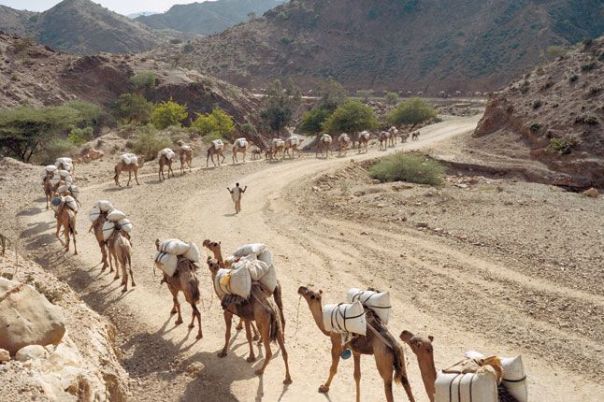
The Ethiopian desert is a harvest of salt to be transported by camel caravan. Only a few men were needed to tend large numbers of camels.
Along our route were ancient Khans (simple Inns for lodging and food for caravaners). Some ancient structures remain partially intact. The antiquities authority has provided information stations along the way to make the journey more meaningful.

Few tours to Israel have time for these journeys. The map shows two spice routes from Jordan through Israel to the Mediterranean port.
Our route towered above the canyons. Staying high on the mountain crest was the only way to keep cool as valley floor temperatures could reach 115-degrees fahrenheit.
ANCIENT CHRISTIAN CHURCHES
In all this history and beauty, one thing has struck Carol and I repeatedly and that is the history of the spread of Christianity in this Sacred Bridge. Our journey through Jordan was conspicuously punctuated with that fact through the ancient Christian church mosaics unearthed by archaeologists from the north to the south. Though Jordan is an Islamic country each hotel we stayed in proudly displayed large mosaics on their lobby walls. Each of these mosaics was from an ancient church. The heritage of the area is clear: Christ reigns there.
Our mandate is to declare Him Lord of the region and call forth this ancient heritage and inheritance once again until the Light of the world is once again blazing bright.
The Church of Jerusalem
In the Cardo, in the Jewish Quarter of Jerusalem, there is also a mosaic uncovered in Madaba, Jordan, near Mount Nebo. It is a mosaic map of ancient Israel focusing mostly on Jerusalem and the Nea Church there in 540 AD.
Sixth century Jerusalem is depicted in the center of this mosaic map. The red lettering in the white area at top reads, “Hagia Polici Yerusalem” — “The Church of the City of Jerusalem,” The main street of Roman times, the Cardo, is central in the mosaic: the colonaded shopping mall that bisected the city.
A Sacred Bridge of the Future
The story of the Sacred Bridge is not finished. What seems to the thousands of tourists that visit, a historical era of the past, has yet to see its crowning splendor. Israel’s own, Ben Gurion declared that the future of the region would be brought to fullness when technology brought life and agriculture to those deserts. There are those who know, and can appreciate, what God has proclaimed about the region. Not just the bridge itself, but the surrounding neighboring nations and peoples being pulled into the vortex of His glory: Egypt, Jordan, Israel, Assyria (Syria, Lebanon, Nineveh, and Iraq. Though the boundary lines of the region have changed multiple times through the centuries, the dawn of God’s intentions for His people remains firmly intact. He sends us as forerunners to make the path straight and prepare the way.
Pray for the peoples of the region as God draws all men to the light of His glory.
The Prophet’s Dance
The prophet sat in a daze with that thousand-mile stare of one seeing beyond the shadowlands of the physical world. Isaiah’s scribe knew the look, and immediately took up pen and scroll ready for what was coming. He was a trained scribe—God’s secretary—recorder of the timeless world of a holy throne room.
Isaiah rose, lifted his hands, and began to move about the room almost in a dance, looking first toward the north, then the south, and not neglecting east and west with his intent gaze and squinted eyes as if trying to make something out in a haze. Circling and circling, the prophet moved until he was finally spinning so that his robe responded to the centrifugal force in a great circle. Dust rose from the stone floor and Isaiah’s growling other-worldly voice began repeatedly pronouncing,
“Mitzraim, Mitzraim, Mitzraim…..!”
His countenance turned toward the south in the direction of Mitzraim (Egypt)—Israel’s southern neighbor—who had at times been a friend, at other times a foe.
The words were tumbling forth now, painting the vision for the hand armed with pen and scroll.
The great and mighty nation’s woes spilled out of the prophet’s mouth like a waterfall. Isaiah spoke like a thunderstorm in another voice, a perfect voice filled with authority and majesty colored by Heaven. The scribe shuddered. It seemed that the prophet controlled the atmosphere in the room like a mighty storm so that the everyday objects of the palace faded into a shroud of the dark prophecy.
The very God of Heaven rode down on Isaiah’s words to touch Earth in His fire. “Kings . . .” and “war . . .” spilled out; “brother against brother”; “terrors…” and “devastation…” darkened the room. Depression swirled in the circle with Isaiah’s flowing robe. There was no time for emotional paralysis—the words were coming in a rush. The hand hurried to keep up; the swift scrawling letters imprinted matched the urgency of the prophet’s message.
Then Isaiah stopped; his head tilted as if to hear something more clearly. A light seemed to break through the dark clouds of the prophetic flow reflecting in the prophet’s face. His lips began to slowly, silently, form another word,
“Sun . . . sun . . . the sun . . . Heliopolis will speak Hebrew,” the prophet whispered.
The city, named for the sun god of the Egyptians, would speak Hebrew? The scribe shifted in his seat, sitting more uprightly . . . more was pouring forth from Isaiah’s mouth.
“It will be a sign to the Lord of Hosts . . . “
Isaiah bent at the waist, groaning as if giving birth. Tears spilled as he began slowly spinning again. For awhile, no words came, just the dance: the bent stature, the spinning in silence. Then Isaiah stopped abruptly. “Come, Yuval . . .”
Isaiah hurried out of the palace toward the stables. He didn’t speak a word as if on pause between segments of a download from Heaven. He merely gestured to the stable boy—two horses. Yuval managed to quickly gather up his inkpot and scroll but hoped the prophet’s words would not flow on horseback. He would have to try to remember them.
From the palace they traveled west and moved to the ridge road that connected Jerusalem with Bethlehem. Turning south they rode in silence; Isaiah’s face set like a flint. Determined, yet not harsh, was the prophet’s appearance. In the distance the hill rose where the southern military armory was located at Talpiot. A smaller path led up the hill eastward to the armory. Isaiah guided his horse east and upward. Upon arrival, they skirted the armory to the east and turned the corner to the south side and a long promontory that seemed to end in space, high above the deep valley that separated Jerusalem from Bethlehem.
There, Isaiah stopped, dismounted, and stared southeast. As if in a dream, he spoke to no one in particular,
“The King’s Highway.” He stroked his beard, “Oh God! My God!” the words escaped his lips on a soft breath, not pleading, rather in wonder.
He lifted a hand as if tracing the route of the King’s Highway that traversed the far ridge of mountains on the other side of the River Jordan.
“That’s the highway . . . Right there it is,” turning slowly southward his hand changed history tracing the highway toward the border of Egypt. “There . . . there . . . Yuval, do you see it? There will be a memorial pillar to the LORD, and beyond, in Heliopolis, an altar. He will rescue them from themselves.
“Three nations, Yuval, three nations . . .”
The prophet bent again as if giving birth. He groaned deeply. He sank to his knees both hands extended upward.
“On that day there will be a highway from Egypt to Assyria. Assyria will go to Egypt, Egypt to Assyria, and Egypt will worship with Assyria.”
Yuval could hardly write . . . What could the prophet be saying? What? Had he lost his mind?
Isaiah now turned northeast, and with hands still extended he uttered,
“On that day Israel will form a triple alliance with Egypt and Assyria—a blessing within the land. The Lord of Hosts will bless them, saying, ‘Blessed be Egypt My people, Assyria My handiwork, and Israel My inheritance.”
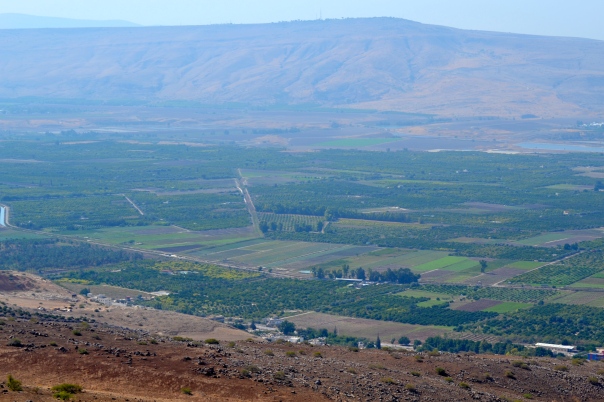
Looking from the mountain ridges of Jordan along the King’s Highway route into Israel, “The Beautiful Land.”
Isaiah ceased speaking. It was a good thing . . . Yuval sat stunned. In his years with the prophet, he had never known him to be wrong, but this . . . Yuval could not speak. He merely stared with Isaiah at the eastern horizon where the highway lay—that famed ancient trade route connecting so many nations of the world.
This, the prophet had uttered, is where hundreds of thousands of feet had previously tread a world-renowned trail would one day be a highway of holiness unto the Lord of Hosts. Enemies would embrace one another in the fear of the Lord.
A tear fell from Yuval’s cheek.
In stunned silence Isaiah rose, gathered himself together, and mounted his horse, awaiting his scribe to do the same.
The sun was sinking in the west and the color embraced them in golden hues as they made their way back to the city of the Great King—where history was fashioned by the hands of a servant of the Almighty, the Most High and Holy God.

Jerusalem of Gold.
(Photo: A scene from National Geographic Entertainment’s “Jerusalem.” NATIONAL GEOGRAPHIC ENTERTAINMENT.)
(Based on Isaiah 19.)

